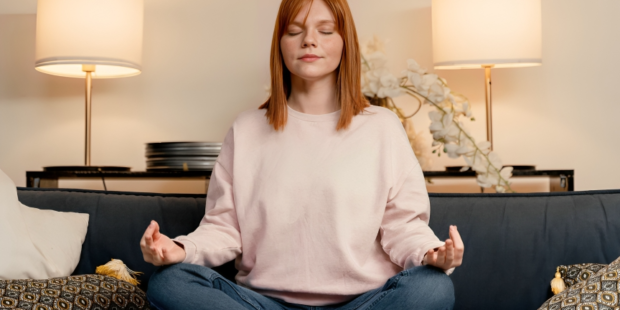Feeling overwhelmed by the daily grind? You’re not alone. In a world that constantly demands our attention, finding moments of calm can seem like a luxury. But mindfulness, a simple practice focusing on being present in the moment, can help you navigate stress and find that much-needed peace.
From deep breathing to mindful meditation, learning how to be fully present can drastically improve your mental and emotional well-being. This article introduces simple mindfulness techniques that are not only easy to practice but also incredibly effective for reducing stress, improving focus, and cultivating a sense of inner calm.
1. Deep Breathing: The Foundation of Mindfulness
A simple yet powerful technique to reduce stress, one breath at a time.
Deep breathing is a cornerstone of mindfulness and can help calm your nervous system in just a few minutes. By focusing on each breath, you slow down your mind and body, promoting relaxation.
How to Practice Deep Breathing:
- Find a Quiet Space: Sit or lie down comfortably in a calm place.
- Breathe In Slowly (4 seconds): Close your eyes, inhale deeply through your nose for a count of four.
- Hold Your Breath (4 seconds): Keep your breath for another count of four.
- Exhale Gently (6 seconds): Slowly release your breath through your mouth, focusing on the sensation of letting go.
Repeat this cycle for 5-10 minutes, and notice how your body begins to relax and your mind quiets down.
2. Meditation for Mental Clarity and Calm
Meditation helps declutter your mind, bringing awareness to the present moment.
Meditation is the practice of focusing on one thing — often your breath, a word, or a sensation — to help clear your thoughts and achieve calm. You don’t need to be an expert; even a few minutes can be beneficial.
How to Meditate:
- Choose a Comfortable Position: You can sit on a chair, on the floor, or even lie down.
- Focus on Your Breath or a Mantra: Inhale and exhale naturally. If your thoughts wander, gently bring your attention back to your breath.
- Set a Timer: Start with 5-10 minutes and gradually work your way up to 20 minutes as you feel more comfortable.
This meditation practice can be your mental reset button, offering a break from the rush and helping you to take control of your thoughts and emotions.
3. Body Scan: Releasing Tension from Head to Toe
Become aware of your body and release tension with a mindful body scan.
A body scan is a mindfulness technique that involves slowly focusing on each part of your body, helping you become aware of any tension you might be holding. This practice is perfect for unwinding before sleep or after a long day.
How to Do a Body Scan:
- Lie Down Comfortably: You can do this in bed, on a yoga mat, or any comfortable flat surface.
- Start from the Top of Your Head: Slowly bring awareness to your head, relaxing your scalp, eyes, and jaw.
- Work Down Your Body: Move your attention down to your neck, shoulders, chest, arms, back, hips, and legs. Notice any sensations, and intentionally release tension from each body part.
- End with Your Feet: Finish by focusing on your toes, feeling a sense of relaxation throughout your body.
The body scan allows you to take control of your thoughts and emotions through physical relaxation, promoting a sense of overall calmness.
4. The Art of Mindful Eating
Turn your meals into a mindful practice to enjoy food more fully and improve digestion.
Mindful eating is about slowing down and savoring each bite, allowing you to fully experience the flavors, textures, and smells of your food. It also helps reduce stress around meals and promotes healthier eating habits.
How to Eat Mindfully:
- Eliminate Distractions: Turn off the TV, put your phone away, and focus on your food.
- Chew Slowly: Take the time to chew each bite thoroughly, paying attention to the texture and flavor.
- Notice Your Body’s Signals: Tune into your hunger and fullness signals, and eat until you feel satisfied, not overly full.
By making mindful eating a part of your daily routine, you’ll enjoy your meals more, reduce stress, and nourish your body effectively.
5. Practicing Gratitude for a Positive Mindset
Cultivating gratitude shifts your focus from stress to positivity and appreciation.
Gratitude is a powerful mindfulness tool that shifts your focus from what’s wrong to what’s right in your life. Practicing gratitude daily can help boost your mood and enhance your overall well-being.
How to Practice Gratitude:
- Start a Gratitude Journal: Each morning or evening, write down three things you’re grateful for.
- Express Gratitude to Others: Take time to thank someone in your life, whether it’s in person, through a message, or in a letter.
- Reflect Before Bed: End your day by recalling moments of joy, achievements, or acts of kindness, no matter how small.
This simple practice can help change your perspective and make you feel more grounded, content, and less stressed.
6. Guided Imagery: Create Your Mental “Spa Weekend”
Visualise a peaceful setting to transport your mind to a place of calm and serenity.
Guided imagery is a visualization technique where you picture a peaceful scene to help relax and calm your mind. Think of it as a mental Spa Weekend, where you can escape for a few moments anytime you need to recharge.
How to Practice Guided Imagery:
- Close Your Eyes and Breathe Deeply: Find a comfortable position and take a few deep breaths to center yourself.
- Visualize Your Happy Place: Picture a location that brings you peace — a beach, a forest, a mountain cabin. Engage all your senses: What do you see, hear, smell, and feel?
- Stay in Your Visualization for 5-10 Minutes: Immerse yourself in this tranquil scene, allowing it to calm your mind and reduce tension.
Guided imagery is a great technique to practice before bed or whenever you feel overwhelmed.
7. Mindful Walking: Bringing Awareness to Each Step
A gentle way to practice mindfulness while on the move.
Mindful walking is a fantastic way to practice mindfulness if you struggle to sit still. By focusing on each step, you connect with your body and the present moment.
How to Practice Mindful Walking:
- Walk Slowly and Intentionally: Choose a quiet space, indoors or outdoors, and walk slowly.
- Notice Your Movements: Pay attention to how your feet touch the ground, how your body moves, and the rhythm of your steps.
- Tune into Your Surroundings: Be aware of the sights, sounds, and smells around you. Let your thoughts drift by without judgment.
Mindful walking not only helps you stay present but also offers a way to get some fresh air and stretch your legs while reducing stress.
Conclusion: Cultivating Calm Through Mindfulness
Incorporating mindfulness into your daily routine is a simple yet effective way to manage stress and find inner peace. Whether it’s through deep breathing, meditation, body scanning, or even mindful eating, these practices can be tailored to fit seamlessly into your lifestyle, bringing moments of calm amid the chaos.
It may take time to develop a consistent mindfulness practice, but the benefits — greater emotional balance, improved focus, and reduced stress — are well worth the effort. Remember, mindfulness is about being kind to yourself and taking life one moment at a time.
So why not start today? Pick one of these techniques and practice it for just a few minutes. Over time, you’ll find that these mindful moments not only reduce stress but help you reconnect with yourself and live more fully in each day.



